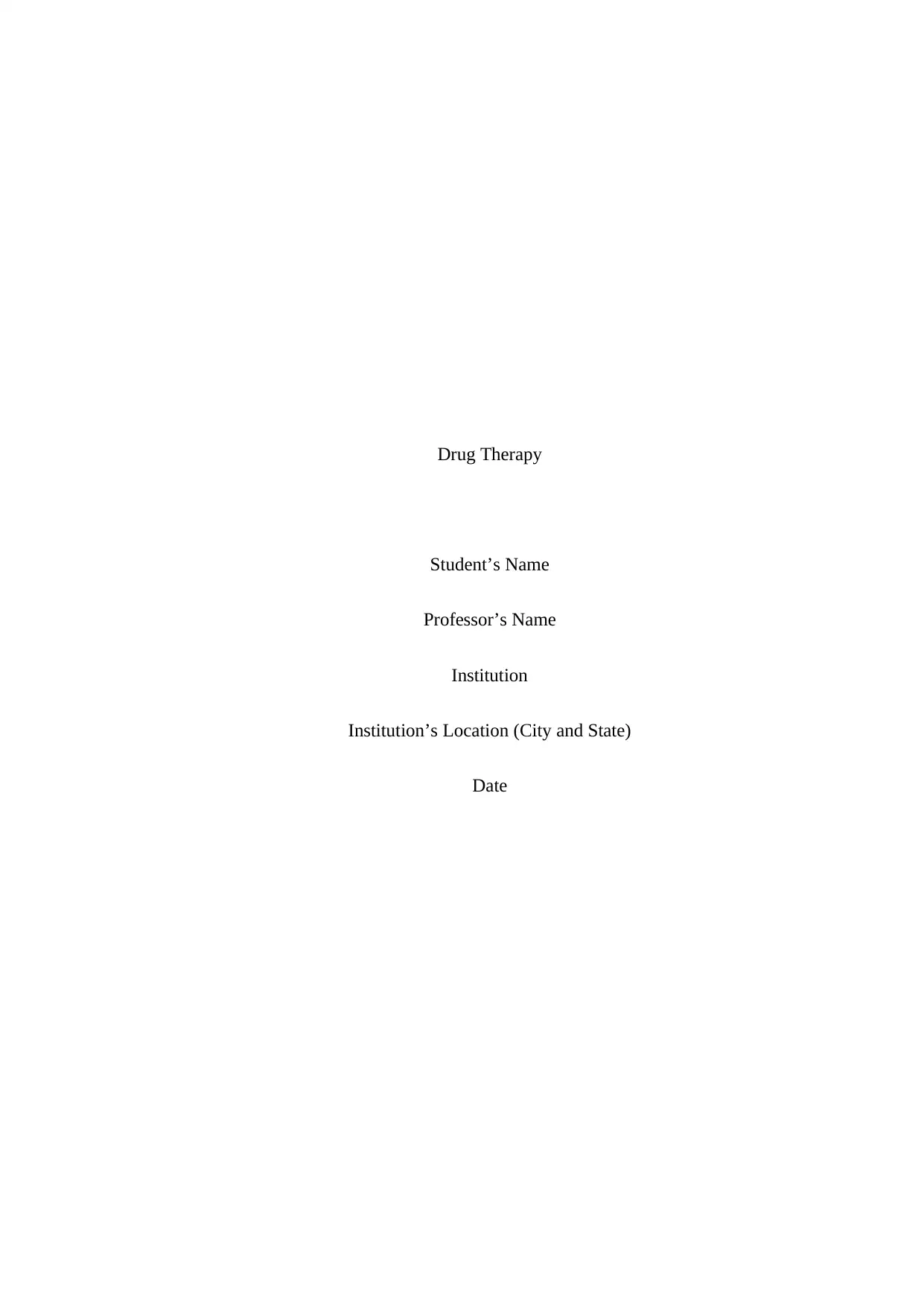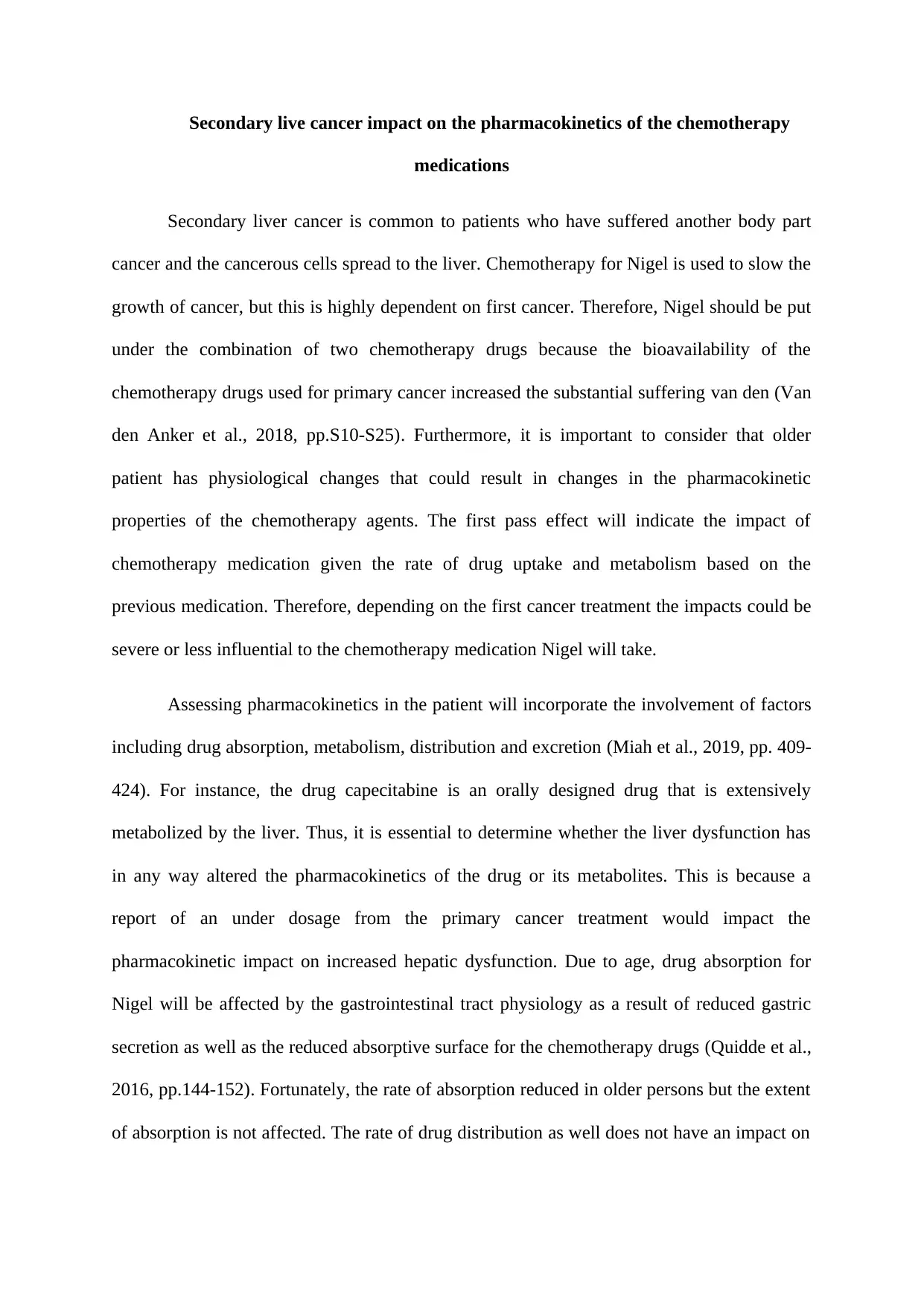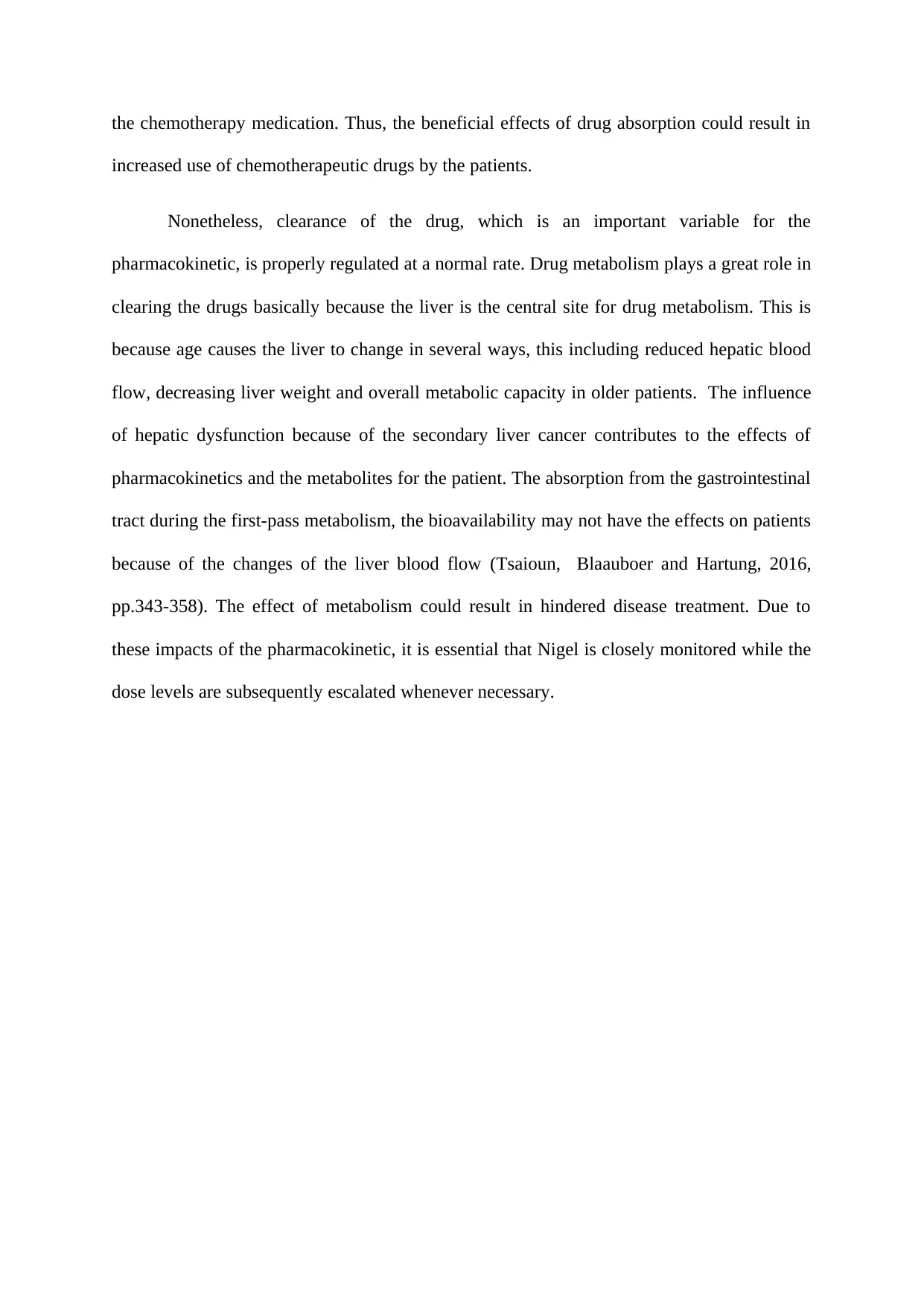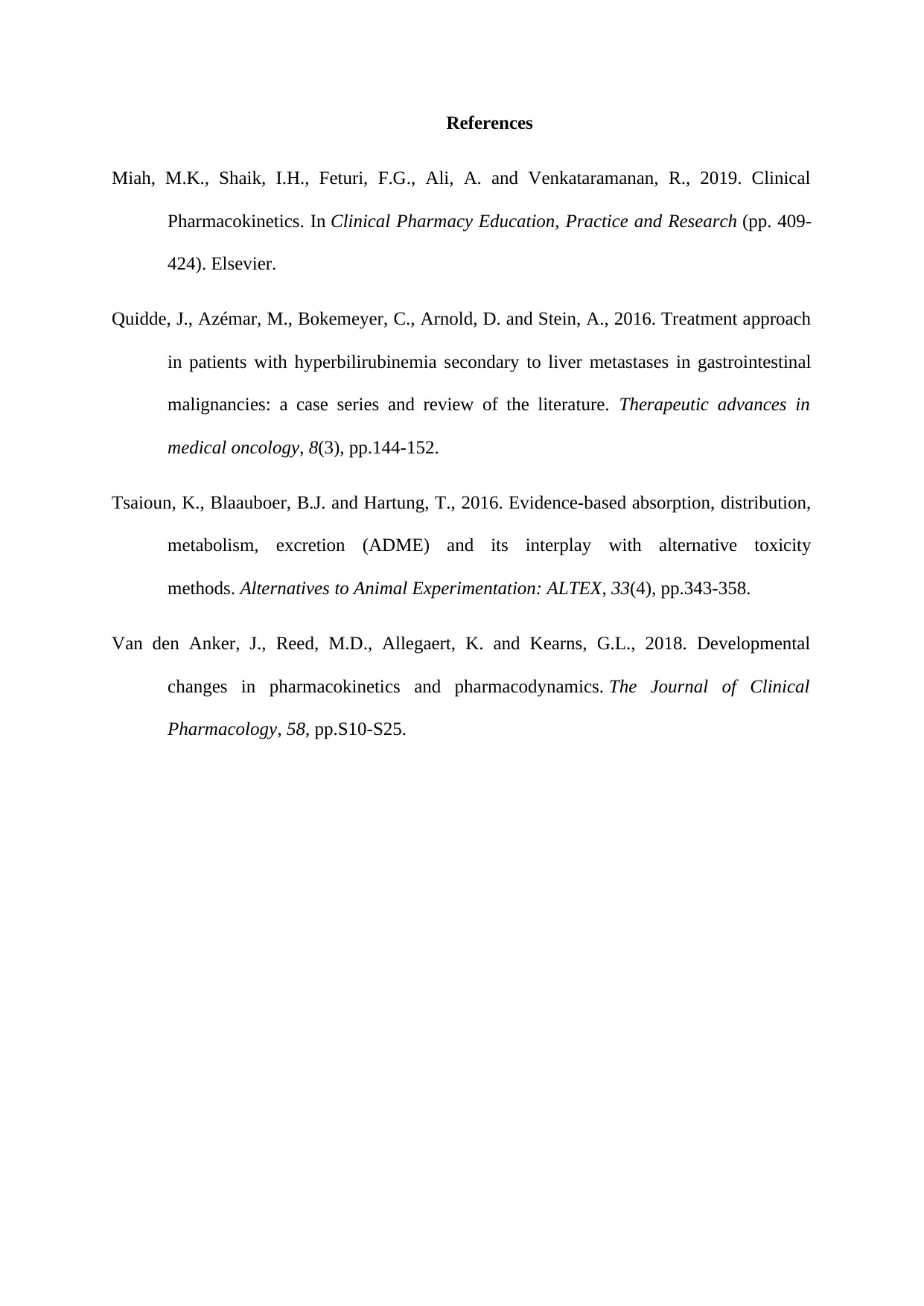Secondary Liver Cancer: Effects on Chemotherapy Drug Pharmacokinetics
VerifiedAdded on 2023/03/30
|4
|626
|321
Essay
AI Summary
This essay discusses the impact of secondary liver cancer on the pharmacokinetics of chemotherapy drugs, particularly in older patients like Nigel. It highlights the importance of considering physiological changes and the first-pass effect from previous cancer treatments. The essay examines factors such as drug absorption, metabolism, distribution, and excretion, noting that liver dysfunction from secondary cancer and age-related changes can significantly affect drug metabolism and clearance. Close monitoring and dose adjustments are recommended to ensure effective treatment. Desklib provides access to similar essays and study resources for students.

Drug Therapy
Student’s Name
Professor’s Name
Institution
Institution’s Location (City and State)
Date
Student’s Name
Professor’s Name
Institution
Institution’s Location (City and State)
Date
Paraphrase This Document
Need a fresh take? Get an instant paraphrase of this document with our AI Paraphraser

Secondary live cancer impact on the pharmacokinetics of the chemotherapy
medications
Secondary liver cancer is common to patients who have suffered another body part
cancer and the cancerous cells spread to the liver. Chemotherapy for Nigel is used to slow the
growth of cancer, but this is highly dependent on first cancer. Therefore, Nigel should be put
under the combination of two chemotherapy drugs because the bioavailability of the
chemotherapy drugs used for primary cancer increased the substantial suffering van den (Van
den Anker et al., 2018, pp.S10-S25). Furthermore, it is important to consider that older
patient has physiological changes that could result in changes in the pharmacokinetic
properties of the chemotherapy agents. The first pass effect will indicate the impact of
chemotherapy medication given the rate of drug uptake and metabolism based on the
previous medication. Therefore, depending on the first cancer treatment the impacts could be
severe or less influential to the chemotherapy medication Nigel will take.
Assessing pharmacokinetics in the patient will incorporate the involvement of factors
including drug absorption, metabolism, distribution and excretion (Miah et al., 2019, pp. 409-
424). For instance, the drug capecitabine is an orally designed drug that is extensively
metabolized by the liver. Thus, it is essential to determine whether the liver dysfunction has
in any way altered the pharmacokinetics of the drug or its metabolites. This is because a
report of an under dosage from the primary cancer treatment would impact the
pharmacokinetic impact on increased hepatic dysfunction. Due to age, drug absorption for
Nigel will be affected by the gastrointestinal tract physiology as a result of reduced gastric
secretion as well as the reduced absorptive surface for the chemotherapy drugs (Quidde et al.,
2016, pp.144-152). Fortunately, the rate of absorption reduced in older persons but the extent
of absorption is not affected. The rate of drug distribution as well does not have an impact on
medications
Secondary liver cancer is common to patients who have suffered another body part
cancer and the cancerous cells spread to the liver. Chemotherapy for Nigel is used to slow the
growth of cancer, but this is highly dependent on first cancer. Therefore, Nigel should be put
under the combination of two chemotherapy drugs because the bioavailability of the
chemotherapy drugs used for primary cancer increased the substantial suffering van den (Van
den Anker et al., 2018, pp.S10-S25). Furthermore, it is important to consider that older
patient has physiological changes that could result in changes in the pharmacokinetic
properties of the chemotherapy agents. The first pass effect will indicate the impact of
chemotherapy medication given the rate of drug uptake and metabolism based on the
previous medication. Therefore, depending on the first cancer treatment the impacts could be
severe or less influential to the chemotherapy medication Nigel will take.
Assessing pharmacokinetics in the patient will incorporate the involvement of factors
including drug absorption, metabolism, distribution and excretion (Miah et al., 2019, pp. 409-
424). For instance, the drug capecitabine is an orally designed drug that is extensively
metabolized by the liver. Thus, it is essential to determine whether the liver dysfunction has
in any way altered the pharmacokinetics of the drug or its metabolites. This is because a
report of an under dosage from the primary cancer treatment would impact the
pharmacokinetic impact on increased hepatic dysfunction. Due to age, drug absorption for
Nigel will be affected by the gastrointestinal tract physiology as a result of reduced gastric
secretion as well as the reduced absorptive surface for the chemotherapy drugs (Quidde et al.,
2016, pp.144-152). Fortunately, the rate of absorption reduced in older persons but the extent
of absorption is not affected. The rate of drug distribution as well does not have an impact on

the chemotherapy medication. Thus, the beneficial effects of drug absorption could result in
increased use of chemotherapeutic drugs by the patients.
Nonetheless, clearance of the drug, which is an important variable for the
pharmacokinetic, is properly regulated at a normal rate. Drug metabolism plays a great role in
clearing the drugs basically because the liver is the central site for drug metabolism. This is
because age causes the liver to change in several ways, this including reduced hepatic blood
flow, decreasing liver weight and overall metabolic capacity in older patients. The influence
of hepatic dysfunction because of the secondary liver cancer contributes to the effects of
pharmacokinetics and the metabolites for the patient. The absorption from the gastrointestinal
tract during the first-pass metabolism, the bioavailability may not have the effects on patients
because of the changes of the liver blood flow (Tsaioun, Blaauboer and Hartung, 2016,
pp.343-358). The effect of metabolism could result in hindered disease treatment. Due to
these impacts of the pharmacokinetic, it is essential that Nigel is closely monitored while the
dose levels are subsequently escalated whenever necessary.
increased use of chemotherapeutic drugs by the patients.
Nonetheless, clearance of the drug, which is an important variable for the
pharmacokinetic, is properly regulated at a normal rate. Drug metabolism plays a great role in
clearing the drugs basically because the liver is the central site for drug metabolism. This is
because age causes the liver to change in several ways, this including reduced hepatic blood
flow, decreasing liver weight and overall metabolic capacity in older patients. The influence
of hepatic dysfunction because of the secondary liver cancer contributes to the effects of
pharmacokinetics and the metabolites for the patient. The absorption from the gastrointestinal
tract during the first-pass metabolism, the bioavailability may not have the effects on patients
because of the changes of the liver blood flow (Tsaioun, Blaauboer and Hartung, 2016,
pp.343-358). The effect of metabolism could result in hindered disease treatment. Due to
these impacts of the pharmacokinetic, it is essential that Nigel is closely monitored while the
dose levels are subsequently escalated whenever necessary.
⊘ This is a preview!⊘
Do you want full access?
Subscribe today to unlock all pages.

Trusted by 1+ million students worldwide

References
Miah, M.K., Shaik, I.H., Feturi, F.G., Ali, A. and Venkataramanan, R., 2019. Clinical
Pharmacokinetics. In Clinical Pharmacy Education, Practice and Research (pp. 409-
424). Elsevier.
Quidde, J., Azémar, M., Bokemeyer, C., Arnold, D. and Stein, A., 2016. Treatment approach
in patients with hyperbilirubinemia secondary to liver metastases in gastrointestinal
malignancies: a case series and review of the literature. Therapeutic advances in
medical oncology, 8(3), pp.144-152.
Tsaioun, K., Blaauboer, B.J. and Hartung, T., 2016. Evidence-based absorption, distribution,
metabolism, excretion (ADME) and its interplay with alternative toxicity
methods. Alternatives to Animal Experimentation: ALTEX, 33(4), pp.343-358.
Van den Anker, J., Reed, M.D., Allegaert, K. and Kearns, G.L., 2018. Developmental
changes in pharmacokinetics and pharmacodynamics. The Journal of Clinical
Pharmacology, 58, pp.S10-S25.
Miah, M.K., Shaik, I.H., Feturi, F.G., Ali, A. and Venkataramanan, R., 2019. Clinical
Pharmacokinetics. In Clinical Pharmacy Education, Practice and Research (pp. 409-
424). Elsevier.
Quidde, J., Azémar, M., Bokemeyer, C., Arnold, D. and Stein, A., 2016. Treatment approach
in patients with hyperbilirubinemia secondary to liver metastases in gastrointestinal
malignancies: a case series and review of the literature. Therapeutic advances in
medical oncology, 8(3), pp.144-152.
Tsaioun, K., Blaauboer, B.J. and Hartung, T., 2016. Evidence-based absorption, distribution,
metabolism, excretion (ADME) and its interplay with alternative toxicity
methods. Alternatives to Animal Experimentation: ALTEX, 33(4), pp.343-358.
Van den Anker, J., Reed, M.D., Allegaert, K. and Kearns, G.L., 2018. Developmental
changes in pharmacokinetics and pharmacodynamics. The Journal of Clinical
Pharmacology, 58, pp.S10-S25.
1 out of 4
Related Documents
Your All-in-One AI-Powered Toolkit for Academic Success.
+13062052269
info@desklib.com
Available 24*7 on WhatsApp / Email
![[object Object]](/_next/static/media/star-bottom.7253800d.svg)
Unlock your academic potential
Copyright © 2020–2025 A2Z Services. All Rights Reserved. Developed and managed by ZUCOL.




